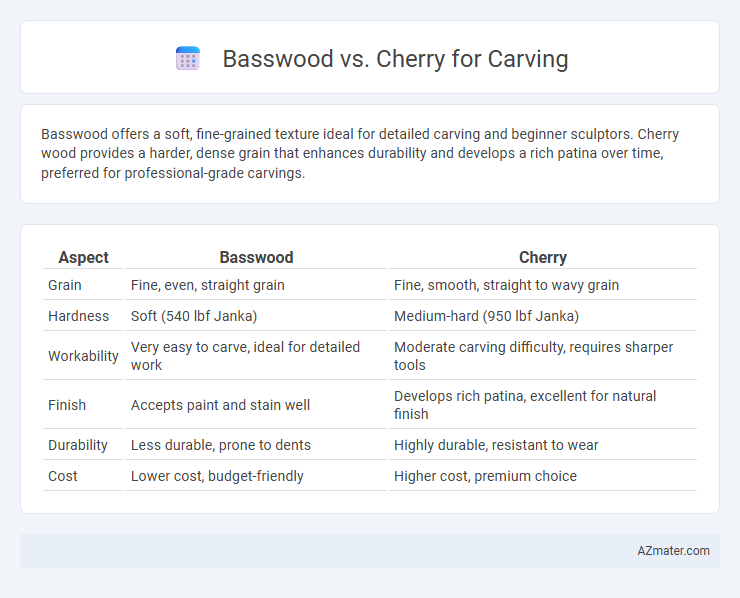Basswood offers a soft, fine-grained texture ideal for detailed carving and beginner sculptors. Cherry wood provides a harder, dense grain that enhances durability and develops a rich patina over time, preferred for professional-grade carvings.
Table of Comparison
| Aspect | Basswood | Cherry |
|---|---|---|
| Grain | Fine, even, straight grain | Fine, smooth, straight to wavy grain |
| Hardness | Soft (540 lbf Janka) | Medium-hard (950 lbf Janka) |
| Workability | Very easy to carve, ideal for detailed work | Moderate carving difficulty, requires sharper tools |
| Finish | Accepts paint and stain well | Develops rich patina, excellent for natural finish |
| Durability | Less durable, prone to dents | Highly durable, resistant to wear |
| Cost | Lower cost, budget-friendly | Higher cost, premium choice |
Introduction: Basswood vs Cherry for Carving
Basswood is favored for carving due to its fine, even texture and soft, lightweight nature, which allows detailed work with minimal tool resistance. Cherry, while harder and denser, offers a rich, warm color and smooth finish that develops a deep patina over time, making it ideal for durable, elegant carvings. Choosing between basswood and cherry depends on the desired balance between ease of carving and the aesthetic longevity of the finished piece.
Wood Characteristics: Basswood and Cherry Compared
Basswood features a fine, uniform texture with a pale, creamy color, making it extremely easy to carve and ideal for detailed work. Cherry wood presents a smooth, fine grain with a rich reddish-brown hue that darkens over time, offering a harder material that requires more effort but yields a polished, durable finish. Both woods respond well to hand tools, but basswood's softness provides smoother cuts, whereas cherry offers superior strength and a refined surface quality.
Carving Ease: Which Wood is Beginner-Friendly?
Basswood is widely regarded as the most beginner-friendly wood for carving due to its soft, fine grain that allows for easy tool control and smooth cuts, reducing hand fatigue. In contrast, cherry wood, while offering a beautiful finish, is denser and harder, requiring sharper tools and more effort, which can challenge novice carvers. Therefore, basswood provides a forgiving surface that helps beginners develop skills quickly, making it the preferred choice for those new to wood carving.
Grain and Texture Differences
Basswood features a fine, even grain with a soft, uniform texture that allows for smooth, detailed carvings, making it ideal for intricate designs and beginners. In contrast, cherry wood has a tighter, more pronounced grain with a harder texture, offering greater durability and a richer color but requiring sharper tools and more skill to carve. The subtle grain patterns in basswood minimize tool resistance and splintering, whereas cherry's harder fibers create a more challenging but rewarding carving experience with a polished finish.
Tool Compatibility and Wear
Basswood offers superior tool compatibility for carving, as its soft texture allows knives and chisels to glide smoothly, reducing blade wear and increasing precision. Cherry, being a harder hardwood, dulls tools more quickly and requires frequent sharpening, though it yields a finer, more detailed finish due to its dense grain. Choosing basswood minimizes tool wear and maintenance, while cherry demands durable blades and consistent edge upkeep for optimal carving results.
Finish and Appearance After Carving
Basswood offers a smooth, even grain that accepts finishes uniformly, resulting in a clean, matte appearance ideal for intricate carving details. Cherry wood develops a rich, warm patina over time, with a naturally fine grain that enhances carved surfaces and takes glossy finishes beautifully, deepening the wood's color. While basswood provides a softer, lighter base for paint or stain, cherry's durability and natural luster create a polished, elegant look after carving and finishing.
Durability and Longevity of Finished Pieces
Basswood is favored for carving due to its softness and fine, even grain, making it easier to work with but less durable over time compared to cherry. Cherry wood, though harder and requiring more effort to carve, produces finished pieces with greater durability and longevity due to its tight grain and natural resistance to wear. Finished cherry carvings tend to darken and harden with age, enhancing their durability, whereas basswood carvings are more prone to dents and wear but offer smooth detail retention.
Cost and Availability of Basswood and Cherry
Basswood is widely favored for carving due to its affordability and abundant availability, making it an economical choice for beginners and professionals alike. Cherry wood, while esteemed for its rich color and fine grain, tends to be more expensive and less readily accessible in some regions. The cost difference between basswood and cherry significantly influences project budgets, with basswood offering a budget-friendly option without sacrificing workability.
Best Uses for Each Wood Type in Carving Projects
Basswood offers a soft, fine grain ideal for detailed and intricate carving projects, making it perfect for beginners and delicate designs such as figurines, reliefs, and decorative accents. Cherry wood's harder texture and rich, reddish-brown hue provide durability and a smooth finish, suited for more advanced carving projects like furniture embellishments, sculptural pieces, and items requiring strong, lasting detail. Each wood excels in different applications--basswood for ease of cutting and fine detail, cherry for strength and aesthetic depth in finished carvings.
Conclusion: Choosing Between Basswood and Cherry
Basswood offers a soft, fine-grained texture ideal for detailed carving and beginners due to its ease of shaping and minimal wear on tools. Cherry, in contrast, provides a harder, denser wood with a rich color and smooth finish, suited for experienced carvers seeking durability and elegant results. Selecting between basswood and cherry depends on the carver's skill level and project requirements, prioritizing ease and detail versus strength and aesthetic appeal.

Infographic: Basswood vs Cherry for Carving
 azmater.com
azmater.com